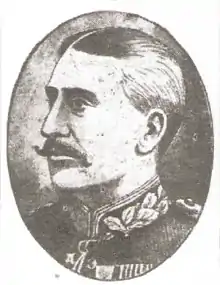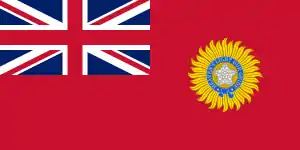Arthur Power Palmer
General Sir Arthur Power Palmer, GCB, GCIE (25 June 1840 – 28 February 1904) was Commander-in-Chief, India between March 1900 and December 1902.
Sir Arthur Power Palmer | |
|---|---|
 Sir Arthur Power Palmer | |
| Born | 25 June 1840 Kurubul, India |
| Died | 28 February 1904 (aged 63) London, United Kingdom |
| Buried | |
| Allegiance | |
| Service/ | |
| Years of service | 1857–1902 |
| Rank | General |
| Commands held | Indian Army |
| Battles/wars | Tirah Campaign |
| Awards | Knight Grand Cross of the Order of the Bath Knight Grand Commander of the Order of the Indian Empire |
Military career
Power Palmer was born in June 1840, at Karnaul (Karnal), India, the son of Nicholas Palmer and Rebecca Carter Barrett.[1] Educated at Cheltenham College, he was commissioned into the 5th Bengal Native Infantry in 1857.[2] He took part in subduing the Indian Mutiny in 1857.[2]
In 1880, he was appointed Assistant Adjutant-General in Bengal and in 1885 was Commander of the 9th Bengal Cavalry for the Suakin Expedition.[2] In 1897 he took part in the Tirah Campaign.[2] He was also General Officer Commanding 2nd Division during the action at Chagru Kotal.[2]
In January 1898, he became Commander-in-Chief Punjab Command[3] and 19 March 1900 he became Commander-in-Chief, India,[4] a post he held for two years.[2]
In a farewell dinner held at Simla in late October 1902, the Viceroy, Lord Curzon said the following about their relationship:[5]
″I believe an impression prevails in outside circles that either the Commander-in-Chief in India leads the viceroy by the nose, or, more rarely, the Viceroy leads the Commander-in-Chief. But there is a third alternative, which, after all, is more likely, and which my experience of two Commanders-in-Chief leads me unhesitatingly to endorse. It is that neither party is ahead of the other, but both are abreast.
I am confident that Sir A. Power Palmer will support me when I say that this has been the happy and unbroken nature of our collaboration.″
(Lord Curzon would later clash with Palmer's successor, Lord Kitchener, and resign as a result.)
Palmer returned to the United Kingdom in December 1902, and retired from the Army. He died in London in 1904 and is buried at Brompton Cemetery.[2]
Honours
- KCB: Knight Commander of the Order of the Bath
- GCB: Knight Grand Cross of the Order of the Bath
- GCIE: Knight Grand Commander of the Order of the Indian Empire - 9 November 1901 - King's birthday Honours[6]
Family
In 1867 he married Julia Helen Aylmer née Harris (1848–1896)[7] who died in October 1896 and is buried at the Old Christian Cemetery, Abbottabad,[8] Pakistan. they had a daughter Norah Blanche Aylmer née Palmer (1872–?) who married Major Gerard Beechey Howard Rice (1865–?); then in 1898 he married Constance Gabrielle Richardson née Shaw (1864–1912), widow of Walter Milton Roberts. He went on to have two more daughters with Constance: Celia de Courcy née Power-Palmer (1902–1973) and Frances Gabrielle née Power-Palmer (c1903–1987).[2]
Further reading
- Who Was Who 1897–1916 p545
- Oxford Dictionary of national Biography pp475–6
References
- British Library IOR Ref No. N/1/56f.124, and L/MIL/9/240f.325
- Arthur Power Palmer at Oxford Dictionary of National Biography
- "New commander in India; General Sir Arthur Power Palmer Succeeds General Sir William Lockhart" (PDF). The New York Times. 17 January 1898. Retrieved 18 February 2018.
- "No. 27299". The London Gazette. 26 March 1901. p. 2114.
- Quoted in "Latest Intelligence". The Times (36902). London. 18 October 1902. p. 7.
- "No. 27374". The London Gazette (Supplement). 9 November 1901. p. 7287.
- British Library IOR Ref No. N/1/121/92
- British Library IOR Ref No. N/1/254/225
External links
- Papers of Sir Ralph Oakden at the Library of Congress Web Archives (archived 2001-11-25)
| Military offices | ||
|---|---|---|
| Preceded by Sir William Lockhart |
Commander-in-Chief, India 1900–1902 |
Succeeded by Lord Kitchener |
.svg.png.webp)
